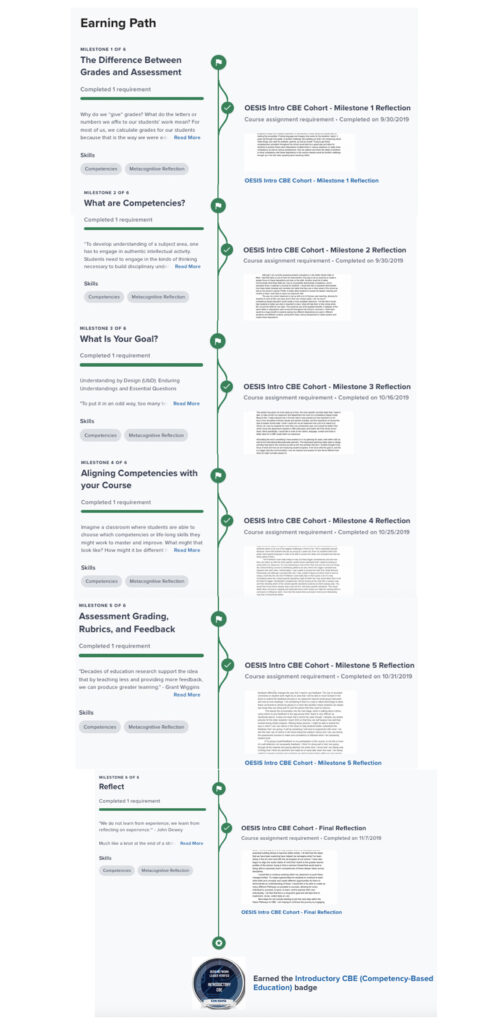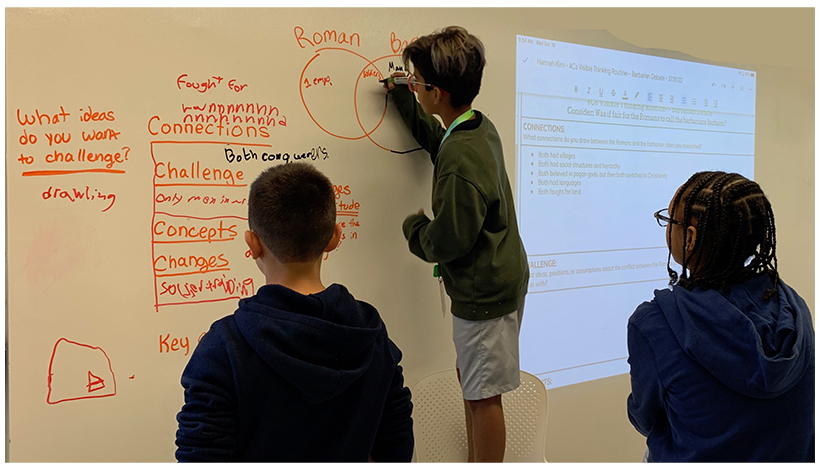In 2014 it finally registered that I needed to change the way I approached teaching my students. Until then, my middle school Humanities classes had always conducted several research projects, increasing in complexity during the year. However, my colleagues and I began to notice that students were less on task and engaged in the steps involved with researching and writing a paper. At the same time, I became interested in both Project-Based Learning and Guided Inquiry Design, thinking an increased level of student autonomy and opportunity in my classes might help. Over the next five years, my colleagues and I found these approaches to be effective at promoting student agency and engagement, and have slowly transitioned most of our content and instruction to this more student-centered model for our Social Studies curriculum. The more we stepped aside in the classroom, the more we allowed student autonomy and choice; and, the more frustrated we became with our grading system. With a traditional grade book focused on categories such as homework, reading, and writing, we couldn’t seem to recognize and provide feedback on the skills and competencies we were encouraging students to develop: collaboration, communication, and problem-solving. Here is the story of how we reinvented our student experience within the context of a demanding and competitive learning culture.
A key challenge we faced involved the effective management of a classroom full of students working at their own pace towards mastery of these skills and competencies. Some students needed several tries to take notes that reflected their critical thinking or creativity, while others raced through that portion, needing instead to repeatedly revise their “outlines” or graphic organizers for planning their essay. How could we provide formative feedback for all of these milestones with students progressing at different paces? One of the techniques we tried was the use of “playlists” created in our school’s LMS, Schoology. In Schoology, we were able to create playlists through which students progressed using “completion rules.” They would not be able to move to the next step until they had demonstrated proficiency in the previous one, thus avoiding the middle school student’s tendency to race to the finish line without stopping to reflect. These playlists allowed our students to progress at their own rates through the various steps of the process of a scaffolded research PBL while ensuring that we were able to provide useful and timely feedback at each step along the way. If a student revised an initial topic exploration sheet to generate questions on three occasions, we provided specific guidance and feedback through our LMS. Students submitted multiple drafts and progressed through the system at their own rate. Rather than waiting for the entire class to complete a lesson, students could pass into the next one by achieving proficiency.
In much the same way, Portfolium, an integrated system designed to support the CBE philosophy, allows me to provide feedback and individualized progression for faculty involved in the OESIS XP Cohort Pathways: I validate competency and award badges of completion. Participants in the PBL (Project-Based Learning), CBE (Competency-Based Education), and SEL (Social Emotional Learning) pathways are enrolled in a cohort in the OESIS XP Portal and also directed to create a portfolio on Portfolium. The content of the pathways is divided into a set of topical requirements or Milestones, each with a selection of readings, videos, and activities to interact with asynchronously and requiring interactive exchanges with other members of their Cohort.
At the end of each Milestone, participants are asked to submit a demonstration of their competence (a “Requirement”) through Portfolium which I assess. In order to complete the Pathway successfully and to earn the badge that certifies that they have completed the Pathway, participants must receive a “proficient” rating on a requirement before they move on to the next Milestone and associated requirements. This structure and progression allow me to provide feedback to the learner on their progress; if the reflection or submitted demonstration of competency does not meet the standards described either in the assignment or rubric, I can request that the learner revise the submission before they progress to the next requirement. In this way, the experience is personalized and targeted towards learners’ needs and growth. Once they have completed the entire “Pathway,” the progression is visible in their portfolio, including the submissions to each requirement and the associated competencies or skills that are tagged on each one. Through this process, learners are encouraged to keep tweaking and resubmitting if necessary, until they achieve proficiency in the topic. Rather than simply completing a requirement and progressing onto the next without reflecting or processing what has been learned, learners are compelled to engage with the Milestone as a whole and their interaction with it. Ultimately, progressing through the OESIS Pathways allows teachers to experience Competency-Based Education first-hand, helping them to understand the benefit of such an approach in their classes.

My work with OESIS Pathway cohorts was a natural extension of my work teaching sixth-grade Humanities. In our sixth-grade classes, my colleagues and I built a culture of feedback and metacognition to promote growth. For each unit of study, we have a driving question that is related to the essential questions of the course. The projects that students complete are assessed using the learning objectives derived from our core competencies for the 5th and 6th-grade Humanities experience. Rather than giving students feedback on the content or a specific assignment, we provide guidance on the development of their capacities in the areas of communication (written and verbal), critical-thinking, creative-thinking, collaboration, inquiry and questioning, and habits of a learner. Throughout the year, students are provided with strategies and feedback to progress towards increased proficiency of these competencies. We ask students to reflect on their progress, set goals, and continually strive to improve their performance. The content is the vehicle for providing students an arena in which to improve their proficiency in these lifelong learner competences. In the same way, I have worked to provide feedback on the cohort Pathways to help learners think about the larger grain skills they are developing in each one. Asking questions, making suggestions, and providing further guidance are all part of the feedback to increase metacognition and reflection. I ask learners to consider their participation as a tool in their larger growth as a teacher and a coach in the classroom. With a great deal of choice built into the system, allowing participants to select which readings and videos most resonate with them, a Pathway allows for a personalized, on-demand PD experience for teachers.
As teachers strive to best prepare our students for the lives they will lead, solely content-focused curricula are missing the opportunity to help students learn larger grain competencies and skills which can be transferred throughout their lives. Competencies such as collaboration, critical thinking, and creative problem-solving are life-long abilities that help today’s students lead more productive and successful lives. Pathways provide an effective means by which educators can scaffold and guide learners to internalize and develop these capacities and skills.


I would love to see an outline of your core competencies for 6th humanities and the PBL project bank you created.